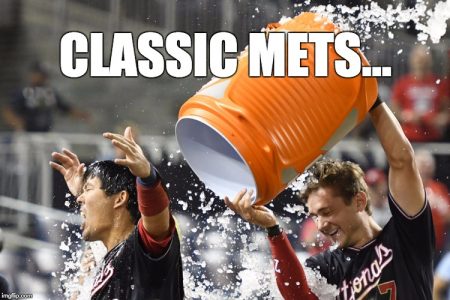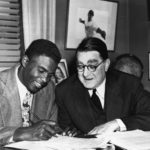The Mets Had a 6-Run Lead in the Ninth—What Happened Next Will Shock You
 As the 144th major league baseball season comes to a close later this month, something unusual happened on Tuesday night September 3rd in Washington, D.C. No, not at the White House or in Congress, but at the ballpark. And the Mets were there.
As the 144th major league baseball season comes to a close later this month, something unusual happened on Tuesday night September 3rd in Washington, D.C. No, not at the White House or in Congress, but at the ballpark. And the Mets were there.
Even for the Mets, a first.
And Now, Ladies and Gentlemen, the Details …
In a back and forth affair that the Mets led 4-2 after six innings, 15 runs were scored in the last two innings. The Mets scored five in the top of the ninth which brought them to a 10-4 lead.
And therein the drama began.
Only three more measly outs in the bottom of the ninth and the game was won. But the Mets best relief pitcher Seth Lugo had been taken out of the game after throwing 10 pitches in a 1-2-3 eighth inning.
So, how does a manager secure the toughest three outs of the game with a swiss cheese bullpen and his best reliever on the bench?
Mickey Calloway had no choice and brought in Triple-A-level pitcher Paul Sewald to open the ninth. 18 pitches and five batters later, Sewald was out. In his third of an inning he allowed four runs on four hits—all earned—a definition of a manager’s nightmare.
Luis Avilan replaced Sewald and pitched to one batter—who singled.
Calloway slowly plodded to the mound—a man with only imperfect choices to consider—and flicked out his right arm as Avilan hurried back to the safety of the dugout.
Calloway called for the righty, Edwin Diaz. Supposedly their 2019 savior.
A few warmup pitches and Diaz was ready.
Diaz worked Kurt Suzuki, the hard-hitting National’s catcher. He threw a couple of unhittable pitches. The crowd roared, hoping. Not delusional. These were the Mets.
The drama heightened to a fevered pitch. Runners on second and third, one out. The winning run at the plate,
Diaz, the pitcher of the 100 mile an hour fastball the Mets acquired for some inexplicable reason from Seattle before the season began (giving up far more than they received for two unnecessary pieces, one of whom will cost them $120 million over the next four seasons), toed the rubber. Maybe only I remembered the simply awful trade Brodie Van Wagenen made acquiring Diaz and Cano soon after he had been anointed General Manager.
Diaz went into his windup and threw his tenth pitch. A fat fastball right down Broadway. Suzuki did not miss.
Bang.
The kind of reverberation only a piece of ash or maple can echo. A declaration. A big part of the un-silent grammar of baseball that everyone understands.
Suzuki paused to eye his blast rocket into the night. The left-field wall beckoned. Very soon, game over.
Jubilation, exultation, screams, and cheers resounded for a few seconds. The world had come to an end. Time stopped. It felt like Washington had just won their first World Series. All these years of frustration. Over.
But it was only one game.
One brief spasm of satisfaction. One paroxysm of delight. But…
For the Mets …
Their 11-10 loss accomplished something that they had never experienced before in their crazy 57-year history.
Their record in all previous games they had been ahead by six runs was 806-0. Today that record is 806-1, according to the Elias Sports Bureau.
To put this in another perspective, the Mets’ improbable collapse against Washington is the first time in 274 games this season when any team leading by six or more runs entering the bottom of the sixth inning had lost the game. So a 274-0 record is now 274-1.
And that one blemish, the New York Mets. Even for the Mets, a first.
And, only the Mets …
Find new ways to lose. Consistently.
Find new ways to embarrass themselves. Consistently.
Find new ways to…
You get the idea. Bad teams find creative ways to lose. Bad teams somehow manage not to fill their coffers with gold. They settle for copper and call it gold.
The good teams do the opposite. Take other teams’ copper and… abracadabra… convert it into gold.
Well, last Tuesday night he seemed rather ordinary. Not worth Jarred Kelenic et al. As the Mets hung their heads and walked off the field. Another defeat. Somewhat more bitter to the taste, but then the Mets lose so often they’re used to it.
But, even for the Mets, a first. A new bittersweet taste to contemplate.
An Improbable First—Why?
Because this first says a lot about the quality of personnel that teams can add to their rosters mid-season to adjust deficiencies.
There’s a reason teams like the Yankees, Dodgers and Astros sit atop the throne of baseball—and it’s not all about money or even geography.
It’s about sagacity. Tenacity. And experience. Why the same teams are overloaded with talent and some teams can never seem to patch the holes that keep rupturing and sinking their chances.
Which Teams?
We all know these teams. They’re at the bottom of the standings. Seattle. Kansas City. Baltimore. And then there are the New York Mets …
The New York Mets?
The New York Mets are an example of a schizophrenic organization. An organization characterized by delusional perceptions of reality that have caused them to make one inconsistent decision after another. They’re not now, nor have they been, a team on the cusp of greatness, contrary to the Wilpon’s hopes and vivid imagination.
Even for the Mets, a first.
Like the recent ridiculous hiring of Brodie Van Wagenen and his misinformed talent evaluations and acquisitions. Another lost season and prime talent. See Jarred Kelenic.
Decisions which in toto have caused the Mets organization to make one irrational decision after another over the years. Decisions which have left the Mets and their team a dysfunctional mess.
Only a few fortunate decisions have changed the teams’ destiny. Mike Piazza. Yoenis Cespedes (for at least for half a season in 2015, before he imploded thereafter as a free agent). I would add Keith Hernandez and Bob Ojeda, but they were strategic choices of General Manager Frank Cashen, who shepherded one of the most exciting and successful ten-year stretches when the Mets were a competitive, functional organization. One of the ten-year epochs when they won a World Series.
Fast Forward
Fast forward to this season, and think about the different Mets teams. There was the first-half squad, a miserable underachieving lot that played to a clumsy 40-50 record at the break.
Then there was the 19-6 Mets immediately after the break, playing against sub-.500 teams, racing to an unbelievable 59-56, within sight of a wild card spot. False hope personified. Not a first for the Mets. The usual.
Now, in the midst of their final 47-game stretch of the season, they are playing against mostly above-.500 teams. So far, the Mets are 12-12 and have reached 71-68. With more difficult games ahead—including the Diamondbacks, Dodgers and Braves.
Someday, the Mets may figure this out. But for the time being, they continue to use their gold to buy copper, like Edwin Diaz, and tell everyone he’s golden.

























